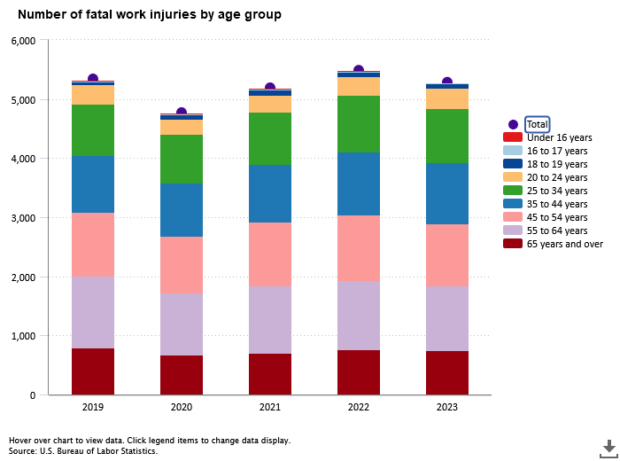Last year, there were 5,283 fatal work injuries recorded in the United States, a 3.7-percent decrease from 5,486 in 2022, the U.S. Bureau of Labor Statistics reported.
The fatal work injury rate was 3.5 fatalities per 100,000 full-time equivalent (FTE) workers, down from 3.7 in 2022.
The data is pulled from the Census of Fatal Occupational Injuries (CFOI).
Some key findings:
- A worker died every 99 minutes from a work-related injury in 2023 compared to 96 minutes in 2022.
- Transportation incidents were the most frequent type of fatal event, accounting for 36.8 percent (1,942) of all occupational fatalities in 2023.
- Fatalities due to violent acts totaled 740 in 2023. Homicides (458) accounted for 61.9 percent of violent acts and 8.7 percent of all work-related fatalities.
- Opioids were the primary source of 162 fatalities and a contributor in an additional 144 fatalities where multiple drugs were the source.
- The fatal injury count and rate for Black or African American workers decreased from 2022 to 2023. The count dropped 10.2 percent from 734 in 2022 to 659 in 2023 and the rate dropped from 4.2 to 3.6 cases per 100,000 FTE workers.
The fatal injury rate for Hispanic or Latino workers decreased from 2022 to 2023, down from 4.6 to 4.4 cases per 100,000 FTE workers.
Transportation incidents were the highest cause of fatalities for both Black or African American (261) and Hispanic or Latino (390) workers in 2023.
The private industry sector with the highest number of Black or African American worker fatalities was transportation and warehousing (200) and for Hispanic or Latino workers it was construction (410).
Foreign-born Hispanic or Latino workers made up 67.1 percent (839) of all Hispanic or Latino worker fatalities (1,250).
Fatalities in the private construction industry sector accounted for 37.5 percent (315) of the 839 foreign-born Hispanic or Latino worker deaths in 2023.
Women accounted for 8.5 percent (447) of all fatalities, but accounted for 18.3 percent (84) of homicides in 2023.
Women had the highest number of fatalities in the private health care and social assistance industry sector (63) followed by the retail trade sector (59).
Workers ages 55 to 64 continued to have the highest number of fatalities in 2023 with 1,089 (20.6 percent of total fatalities). Transportation incidents were the highest cause of fatalities for this age group (401), followed by falls, slips and trips (226).
Workers ages 25 to 34 had the highest number of fatalities due to violent acts (179), including 121 homicides and 58 suicides.
Construction had the most fatalities (1,075) among all industry sectors in 2023, and was the highest for the sector going back to 2011. Falls, slips, and trips accounted for 39.2 percent (421) of all construction fatalities, with transportation incidents accounting for another 22.3 percent (240) of fatalities.
Most fatal falls to a lower level (260 or 64.4 percent) within construction were from a height of between 6 and 30 feet, while 67 fatal falls were from a height of more than 30 feet. Portable ladders and stairs were the primary source of 109 fatalities in construction.
The transportation and warehousing sector had the second most fatalities (930), an 11.7-percent decrease from 1,053 fatalities in 2022. The fatal injury rate among workers in this sector also decreased from 14.1 in 2022 to 12.9 cases per 100,000 FTE workers in 2023.
Transportation incidents accounted for 71.7 percent (667) of fatalities within the transportation and warehousing sector. Roadway collisions with another vehicle accounted for 249 fatalities and roadway collisions with an object other than a vehicle accounted for 193 fatalities. Within this sector 314 fatalities occurred on an interstate, freeway, or expressway and 117 occurred on local roads or streets.
Approximately 30 percent of fatalities in the retail trade industry sector were homicides (94).
Administrative and support and waste management and remediation services had 484 fatalities in 2023. Trees, logs, and limbs were the primary source of 79 of these deaths.
The landscaping and groundskeeping occupation had the most fatalities (102) in this sector, followed by tree trimmers and pruners (80).
Workers in transportation and material moving occupations represented the occupational group with the most fatalities (1,495) in 2023. However, fatalities for this group declined 7.7 percent from 2022, driven by an 11.9-percent decrease in fatal injuries to heavy and tractor-trailer truck drivers. The rate for the occupational group also decreased from 14.6 per 100,000 FTE in 2022 to 13.6 in 2023.
Fatalities among protective service occupations (276) decreased 17.6 percent in 2023, from 335 in 2022. Homicides (93) accounted for 33.7 percent of the fatalities. The rate for this occupational group decreased from 10.2 fatalities per 100,000 FTE workers in 2022 to 8.2 in 2023.
Work fatalities among building and grounds cleaning and maintenance workers (337) decreased in 2023 from 352 in 2022. The 2023 rate was 7.1 fatalities per 100,000 FTE workers and in 2022 it was 7.4. About one-quarter (25.2 percent) of these fatalities were from falls, slips, and trips (85) and another quarter (24.9 percent) were from contact incidents (84).





















 The Future of Knowledge in Insurance: From Training to AI-Powered Productivity
The Future of Knowledge in Insurance: From Training to AI-Powered Productivity  Bankers Readying U.S. IPOs at ‘Overwhelming’ Pace Ahead of 2026
Bankers Readying U.S. IPOs at ‘Overwhelming’ Pace Ahead of 2026  How One MGU Grew Fivefold When Capacity Fled Cat-Prone Property Markets
How One MGU Grew Fivefold When Capacity Fled Cat-Prone Property Markets  The Hardest Part of Innovation in Insurance Isn’t Technology; It’s Culture
The Hardest Part of Innovation in Insurance Isn’t Technology; It’s Culture 